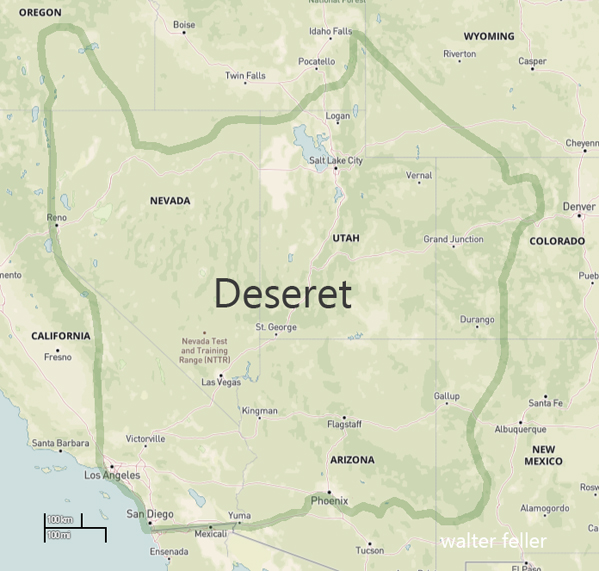Deseret

Proposed State of Deseret 1849-1850
The State Formerly Known as Deseret
April 8, 2016 by Carlyn Osborn - LOC.By the end of 1847, the Church of Jesus Christ of Latter-Day Saints (LDS) had put down roots near the Great Salt Lake in present day Utah. Originally organized by Joseph Smith in 1830, the LDS Church and its adherents continuously moved their headquarters for over a decade: from the Burned Over District in New York, to Ohio, to Missouri, to Illinois, and, eventually, to Utah. When Brigham Young, ordained President of the LDS Church following Joseph Smith’s death, and a group of fellow settlers arrived at the Salt Lake Valley on July 24, 1847, Young looked around and declared, “This is the place.”
Between 1847 and 1848, nearly 5,000 Mormons had settled in the Salt Lake Valley. Seeking formal recognition from the federal government in 1849, they proposed calling themselves the “State of Deseret,” a word borrowed from the Book of Mormon meaning “honeybee.” The honeybee remains an important symbol to both the LDS Church and the state of Utah. A representation of industriousness and hard-work, a beehive surrounded by bees is at the center of both the Utah state flag and the official state seal.
The land that Brigham Young and the LDS Church settled on officially became a part of the United Sates in 1848 following the Mexican-American War and the Treaty of Guadalupe Hidalgo. The federal government, however, rejected Young’s proposed state name and borders. The government found the “State of Deseret” to be an unsuitable name, and instead proposed the name “Utah.” The name Utah had appeared on maps as early as 1720 as yutta, an alternative spelling of Ute, one of the peoples indigenous to the region.
The territories of New Mexico and Utah were established by acts of Congress on September 9, 1850, as part of the Compromise of 1850. Brigham Young was named Utah Territory’s first governor and held the position for eight years, stepping down following the 1858 Utah War. Utah Territory’s newly established borders stretched from California all the way east to the peaks of the Rocky Mountains. The Oregon Territory bordered Utah to the North and the 37th parallel bordered it to the South. The size of the Utah Territory was reduced several times in the proceeding decades.
Silver deposits (known as the Comstock Lode) were discovered in the western part Utah Territory in 1861, which made the federal government uneasy. It was uncertain of the LDS Church’s loyalty during the emerging Civil War and decided to remove this mineral-rich part of the land entirely from the Utah Territory, preventing the Territory from using it as a resource. Utah was in a relatively strategic location during the war because lines of communication between California and the rest of the country ran through the upper right corner of the Territory. If Utah sided with the Confederate states, then the Union would have to move mail and telegraph lines north to be outside the Territory. Relations between the federal government and the citizens of Utah were already strained after the 1858 Utah War, but the chance that Utah would join the confederacy during the Civil War was slim. The entire Territory had only 29 slaves by 1860 and the majority of settlers still had ties to New England. At the end of the War in 1868, the federal government removed the whole upper right corner of the Utah Territory and turned it over to the newly formed Wyoming Territory, giving Utah its distinctive L-shape.